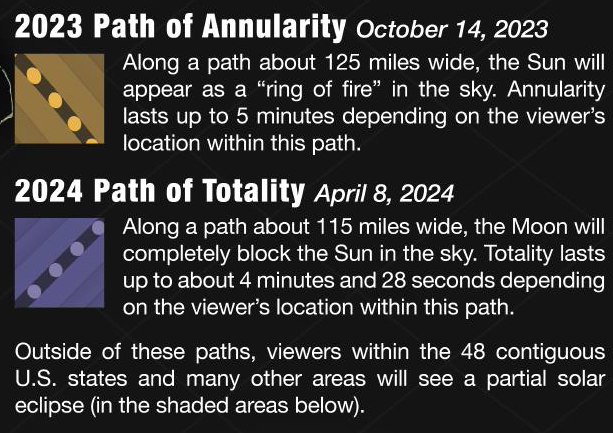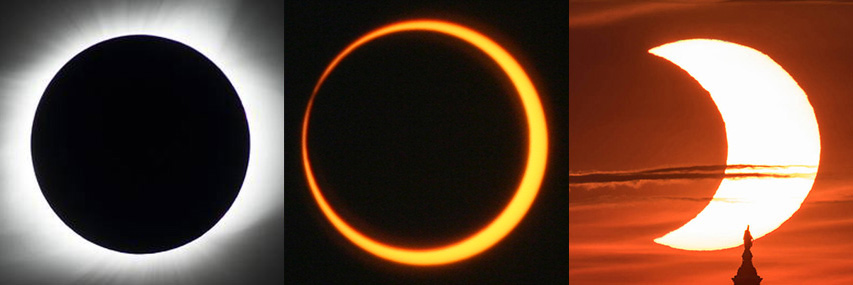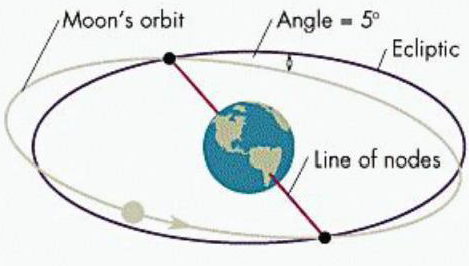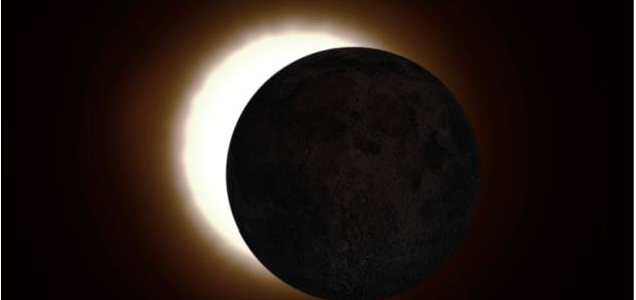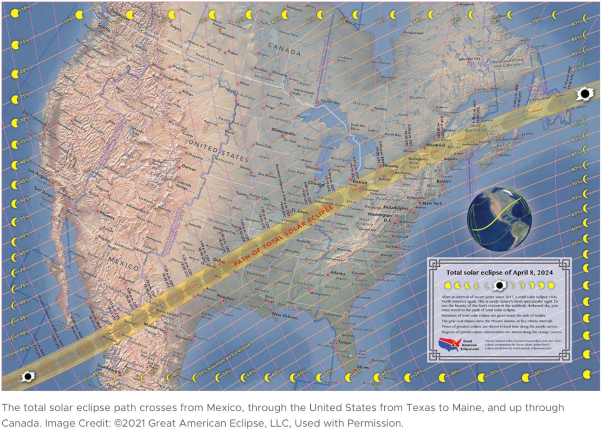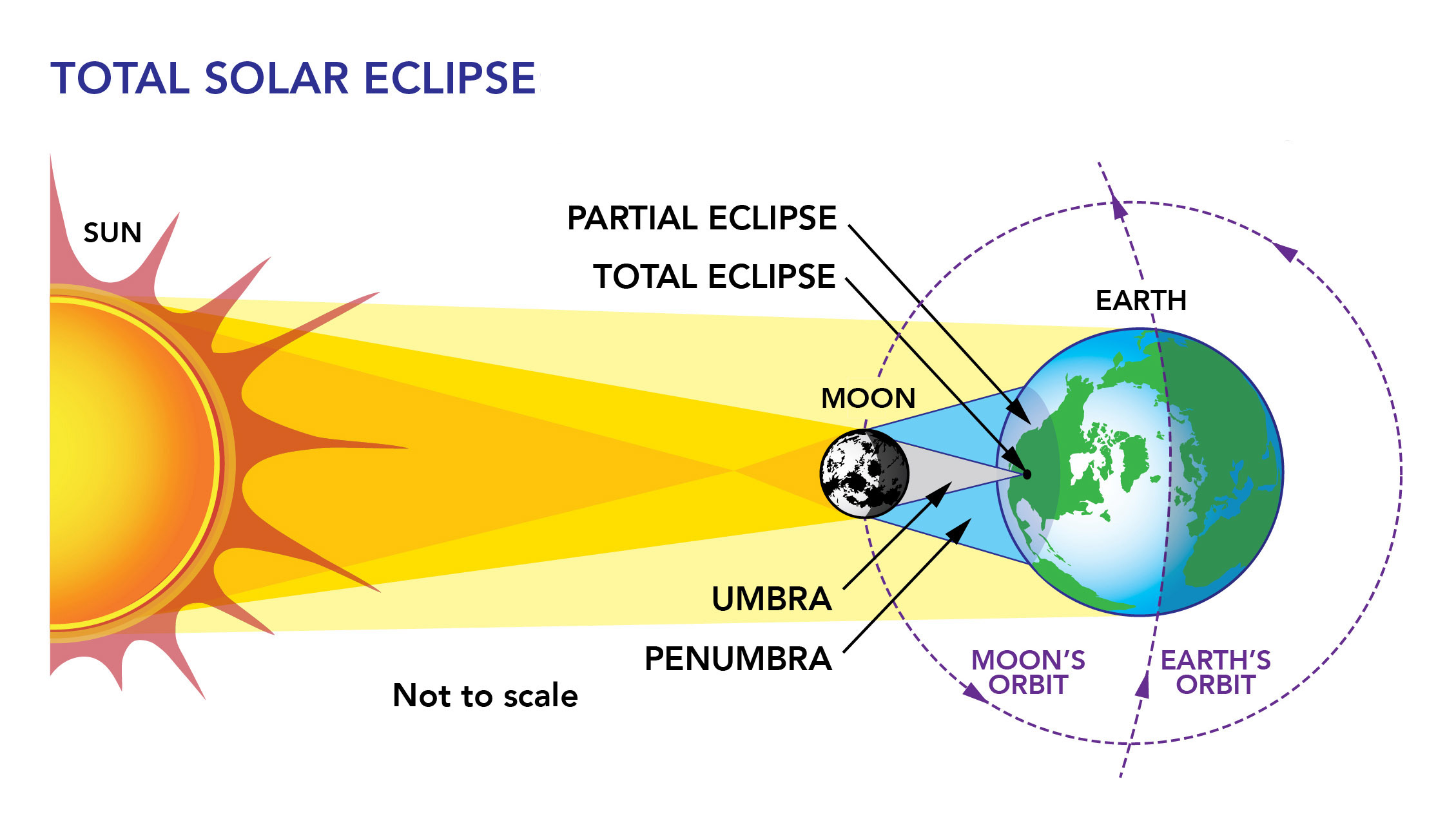Lesson Plans
How to Safely Observe a Solar Eclipse
Overview
In this activity students will learn several ways to safely observe a solar eclipse.
Materials Required
Materials:
- Print Student Sheets
- How to Safely Observe a Solar Eclipse Student Sheets Google Doc OR How to Safely Observe a Solar Eclipse Student Sheets PDF
- 2023 US Annular Eclipse Map and 2024 US Total Eclipse Map (cardstock, recommended)
- Scissors
- Hole Punchers, 5mm recommended
- Circle
- Star
- Other shape, i.e. square, triangle, heart
- Eclipse Safety Quiz Google Form
- Optional: solar eclipse glasses
- Optional: regular sunglasses
- Optional: 3D print 2023 US Annular Eclipse Map and/or 2024 US Total Eclipse Map
Teachers who are interested in receiving the answer key, please complete the Teacher Key Request and Verification Form. We verify that requestors are teachers prior to sending access to the answer keys as we’ve had many students try to pass as teachers to gain access.
Procedure
Remember to never look directly at the Sun without proper safety equipment.
Steps:
-
Gather Background Knowledge: A solar eclipse occurs when the Moon is between the Sun and Earth, and with the right conditions, the Moon casts a shadow on Earth’s surface. Observers experience different types of solar eclipses, depending on what part of the Moon’s shadow the observer is in.
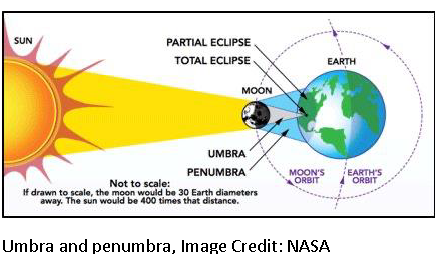
Position of Sun, Moon and Earth during a solar eclipse. https://mynasadata.larc.nasa.gov/sites/default/files/inline-images/Umbra%20and%20penumbra%202_0.png, Credit: NASA The phenomenon of a solar eclipse is possible because even though the Sun is about 400 times larger than the Moon, the Sun is about 400 times farther away from Earth than the Moon is. This ratio of the size and distance of these objects makes them appear the same size in the sky.
Have the students watch the Solar Eclipse Animation.
To experience a total solar eclipse, the observer must be in the umbra shadow of the Moon. The path of the umbra shadow across Earth is called the “path of totality.”
During a solar eclipse, people in locations in the path of totality will experience 2-4 minutes when the shadow completely blocks out the light from the Sun. We call this a total solar eclipse. This is the only time when viewers can remove their solar eclipse glasses.
People who are outside the path of totality, will see a partial solar eclipse, where only part of the Moon’s shadow covers the Sun. Solar eclipse glasses are needed to view a partial solar eclipse. People in different locations will experience different percentages of coverage of the Sun by the Moon’s shadow.
A third type of solar eclipse happens when the Moon is farther away in its elliptical orbit around the Earth and appears smaller, not completely blocking the disk of the Sun, only about 90%. This is called an annular solar eclipse. Because both the Earth and the Moon are moving, on some occasions observers may experience a total and an annular eclipse in the same event, known as a hybrid solar eclipse.
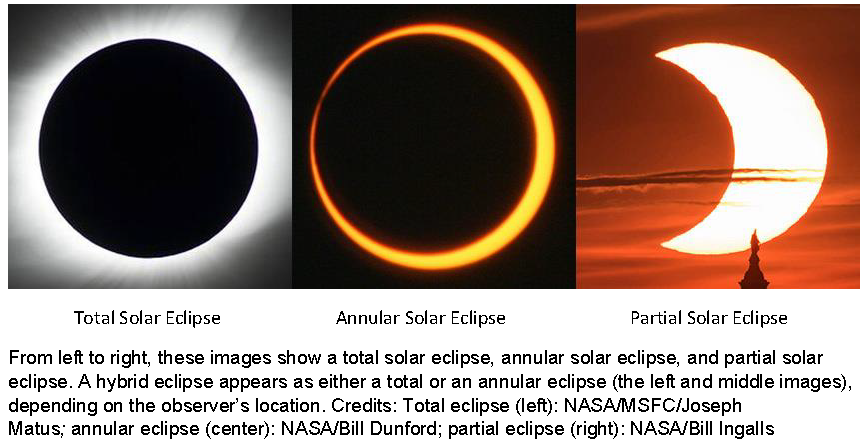
https://mynasadata.larc.nasa.gov/sites/default/files/inline-images/Eclipse%20type%20images_0.png -
Examine Data: The United States will experience all three types of solar eclipses in the coming years! There will be an annular solar eclipse on October 14, 2023 and a total solar eclipse on April 8, 2024. Examine the US map below, showing the paths of these two solar eclipses. Just like there is a path of totality for a total solar eclipse, there is a path of annularity for an annular solar eclipse. You must be on the path of annularity to experience what scientists refer to as the “ring of fire.” People experiencing an annular solar eclipse still need to keep their solar eclipse glasses on the entire time. Everyone outside of the paths will experience a partial solar eclipse, which you also need solar eclipse glasses to view.
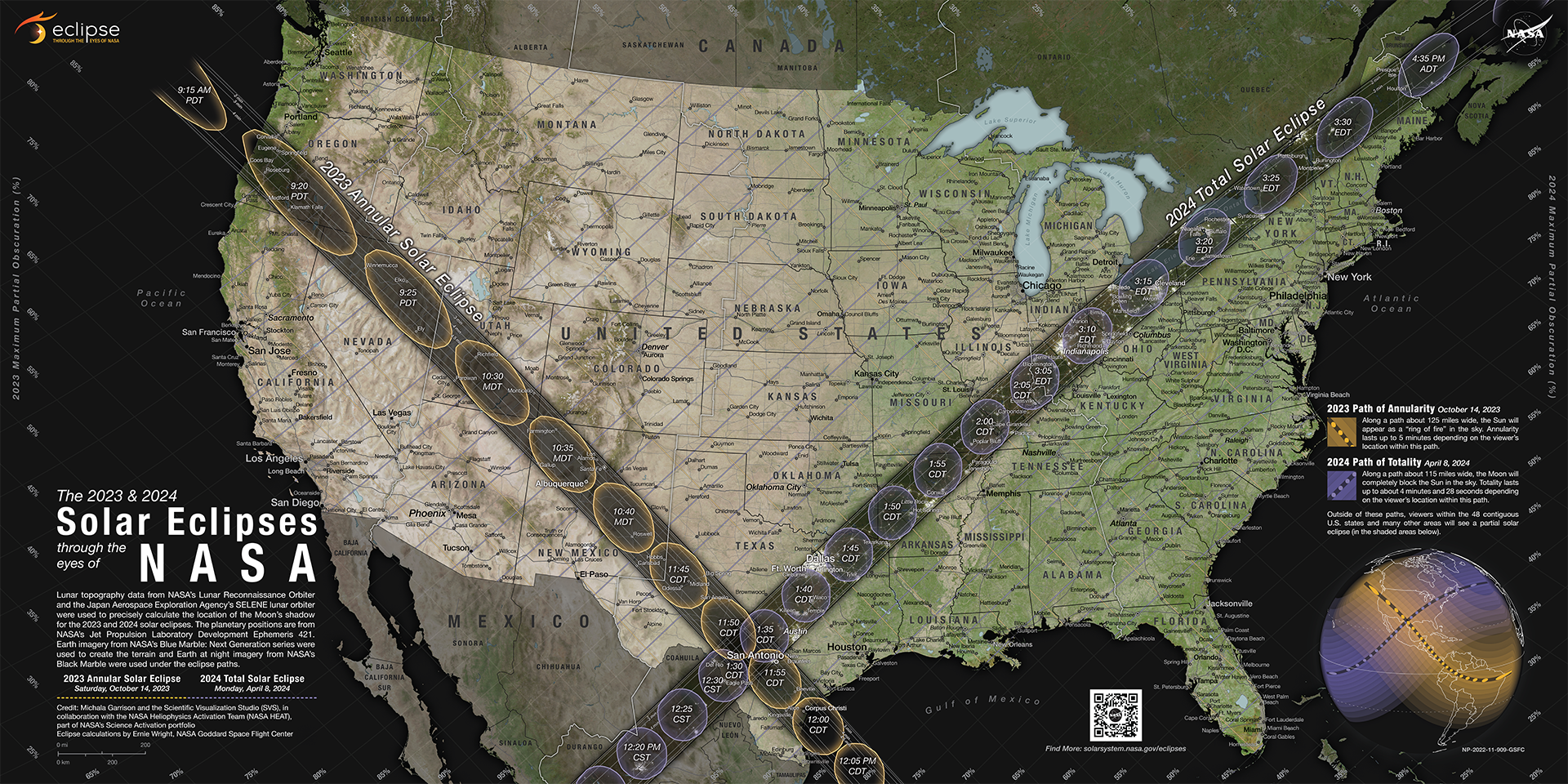
Eclipse Map with Paths of Annularity and Totality, Image Credit: NASA's Scientific Visualization Studio, https://mynasadata.larc.nasa.gov/sites/default/files/inline-images/eclipse_map_1920v2%202023_04_11.png
Click to enlarge map.
Reading the MapInside the paths of totality (100% obscuration) and annularity (90% obscuration) are irregular ovals that delineate the Moon’s shadow on the Earth’s surface, which is irregular in shape due to the shape of the lunar limb (lunar topography), and the topography and curvature of Earth. On the map, the ovals contain times inside corresponding to the shape of the Moon’s shadow cast at that time during the eclipse.
Also within the dark paths are duration contours. These delineate the length of time annularity or totality will last. The closer to the center of the solar eclipse path, the longer it will last. For the annular path, times range from a few seconds on the outer edge to a maximum of around 4.5 minutes in the center. For the total path, times range up to 4 minutes.
Outside the eclipse paths, the map displays contours of obscuration, or percentage of the Sun’s area covered by the Moon. Readers can trace the lines to percent obscuration numbers printed along the left and top of map for the 2023 annular solar eclipse (yellow lines) and along the right and bottom for the 2024 total solar eclipse (purple lines). For example, locations on the 80% line will experience a partial solar eclipse, with only 80% of the Sun being blocked.
Analyze the map: Ask students what they will experience at your location during each of these eclipses?
- What is your location?
- Will you be in the path for either eclipse?
- If so, approximately how long will totality or annularity last at your location?
- If you will experience a partial solar eclipse, how much of the Sun will be obscured at your location for each type of eclipse?
-
Exploring Safe Methods for Viewing the Sun. Always use the proper safety equipment to observe the Sun. Solar filters are 1000 times darker than sunglasses and block all infrared and UV light, and nearly all visible light. If you don’t have solar eclipse glasses or a solar filter for your telescope or binoculars, there are indirect ways to safely observe the Sun, like using a pinhole projector.
Optional: If you have solar eclipse glasses, have students put them on inside. They will immediately experience complete darkness, as the glasses block out nearly all of the light. Have them compare that experience to just regular sunglasses. This is a very effective demonstration at showing how much light the two types of glasses block.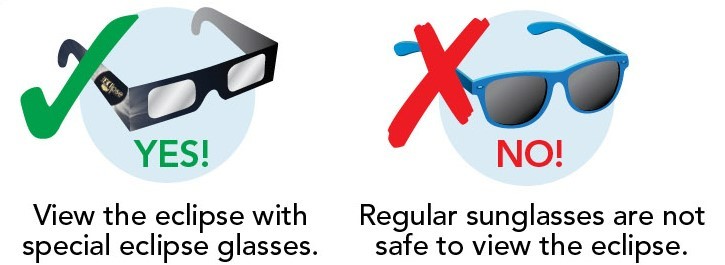
Special eclipse glasses can be used to observe a solar eclipse. Regular sunglasses are not safe to view a solar eclipse., Image Credit: NASA, https://mynasadata.larc.nasa.gov/sites/default/files/inline-images/eclipse%20glasses%20and%20sunglasses.jpg
What is a pinhole projector? Pinhole projectors allowed early scientists to view the shapes of illuminated objects, like the Sun, by shining the light from the object through a very small hole, projecting the image onto the ground or a wall. You can use a paper plate or any heavy paper with a small hole punched in it, or you can use a colander, or just your hands!
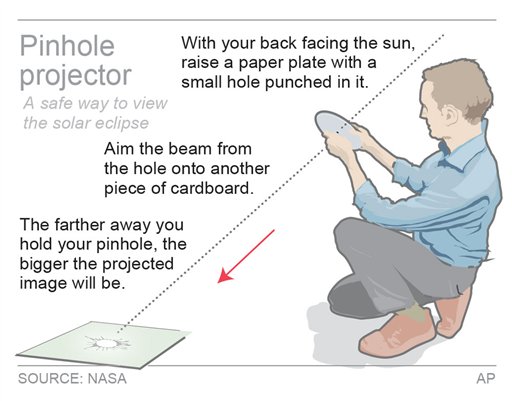
With your back facing the Sun, raise a paper plate with a hole punched in it. Aim the beam from the hole on another piece of cardboard. The further away you hold the pinhole, the larger the projected image will be. https://mynasadata.larc.nasa.gov/sites/default/files/inline-images/PInhole%20projector%20times%20union.jpg, Image Source: Times Union Safety Reminder: Keep your back to the Sun when using a pinhole projector.
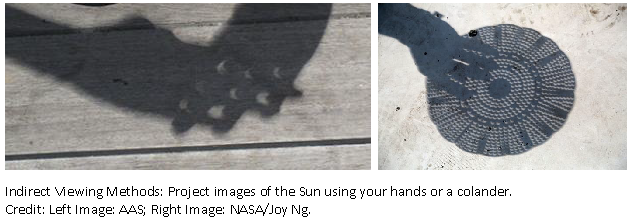
https://mynasadata.larc.nasa.gov/sites/default/files/inline-images/Indirect%20Viewing%20Methods.png - Get ready for 2023
-
2023 Plan A: Indirect Viewing. Use a pinhole projector to indirectly view the solar eclipse. This data driven pinhole projector shows how much of the Sun’s disk is blocked by the Moon at each location on the map during the October 14, 2023 annular eclipse. For example, locations on the 20% line will experience a partial solar eclipse, with only 20% of the Sun being blocked. In fact, technically, an annular solar eclipse is a partial solar eclipse because at maximum annularity, only 90% of the Sun is blocked.
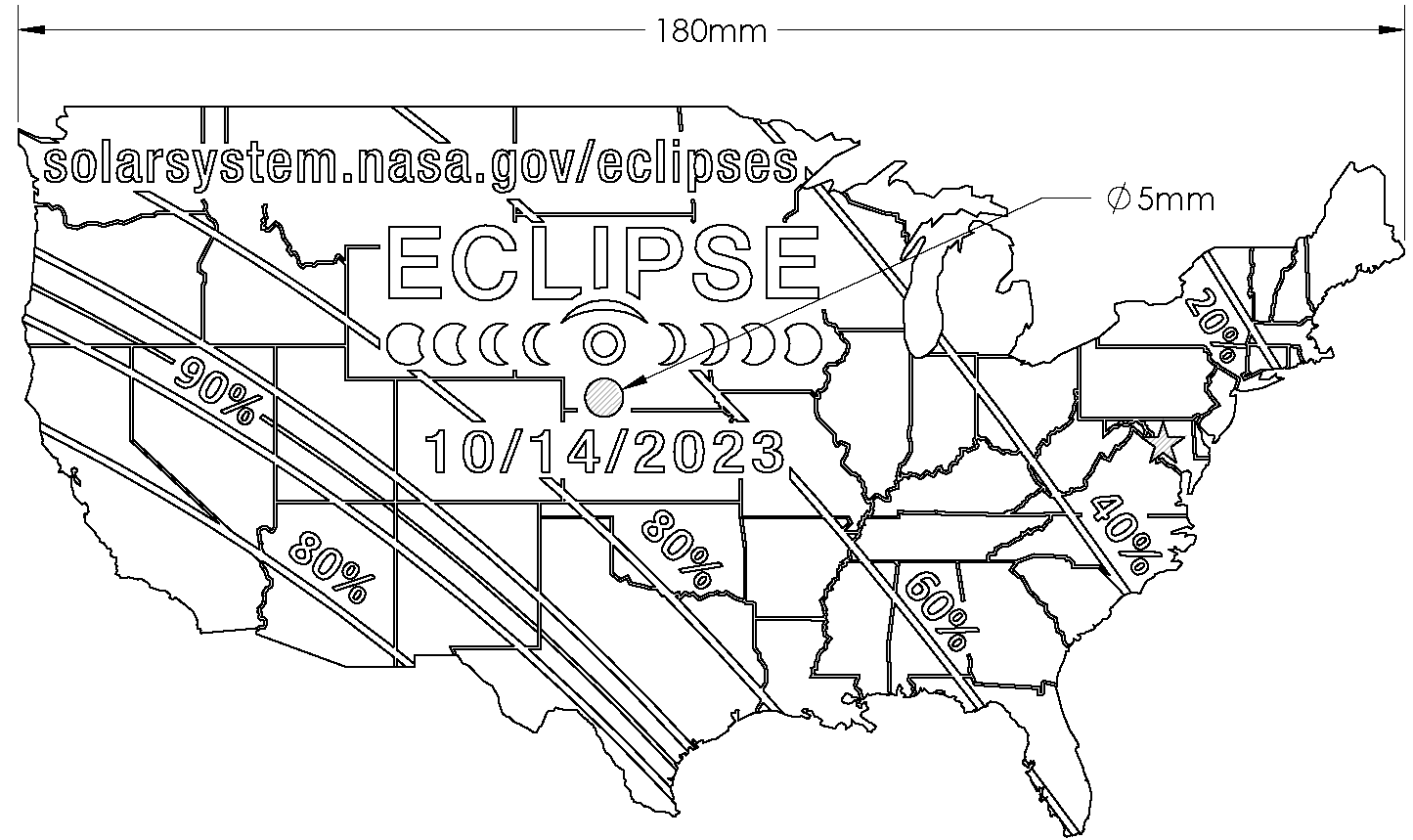
US pinhole projector eclipse map for Saturday, October 14, 2023. Credit: NASA/J. Patrick Haas, https://mynasadata.larc.nasa.gov/sites/default/files/inline-images/USA%20Eclipse%202023%20Pinhole%205mm.png
- Your back should be to the Sun when using a pinhole projector.
- Cut out this pinhole projector of the 2023 Annular Solar Eclipse US Map.
- Hole-punch a circle in the middle of the map and a star over Washington DC.
- Choose one other shape and punch a hole where you live.
- Make a prediction: Have students predict what shape will the Sun be when it is projected through the holes?
- Times not during an eclipse (regular Sun)?
- During a partial eclipse?
- During an annular eclipse?
The shape of the hole in a pinhole projector doesn’t matter. At times not during an eclipse the Sun will always project as round, no matter what the shape of the hole is in, because the Sun is round. During a partial solar eclipse and an annular solar eclipse, the shape of the Sun will be different, depending on how much of the Moon’s disk is blocking the Sun.
Optional:- See the extensions section of this lesson for a prediction activity
- If you don't want to use the template provided, you can make a pinhole projector from a box as shown in the How to Make a Pinhole Projector to View the Solar Eclipse video.
- Your back should be to the Sun when using a pinhole projector.
-
-
2023 Plan B: Direct Viewing: Use solar eclipse glasses to directly view the solar eclipse. Examine the Annular Eclipse Sequence about how to properly use solar eclipse glasses during an annular solar eclipse.

Annular Eclipse Sequence, https://mynasadata.larc.nasa.gov/sites/default/files/inline-images/Annular%20Eclipse%20Sequence.png, Credit: American Astronomical Society
- Ask students:
- For observers experiencing an annular solar eclipse, when do you need to use solar eclipse glasses?
- For observers on the 90% line (path of annularity)?
- For observers experiencing a partial solar eclipse (80%, 60%, 40%, 20%)?
- Ask students:
- Get ready for 2024
-
(Optional) 2024 Plan A: Indirect Viewing: Repeat the procedure for the pinhole projector of the 2024 Total Solar Eclipse US Map. This data driven pinhole projector shows how much of the Sun’s disk is blocked by the Moon at each location on the map during the April 8, 2024 total solar eclipse. For example, locations on the 80% line will experience a partial solar eclipse, with only 80% of the Sun being blocked. Only observers in the path of totality will experience a total solar eclipse, with 100% of the Sun being blocked.
It should be noted that experiencing 100% totality is much, much different than 95%. Even at 95%, the Moon does not block enough of the Sun to cause the unique conditions that occur during a total solar eclipse, which include significant darkening of the sky, even the appearance of stars behind the eclipsed Sun. These conditions affect the air temperature and animal behavior, who begin to act as if it is nighttime! Totality is a unique experience, described by many as like no other.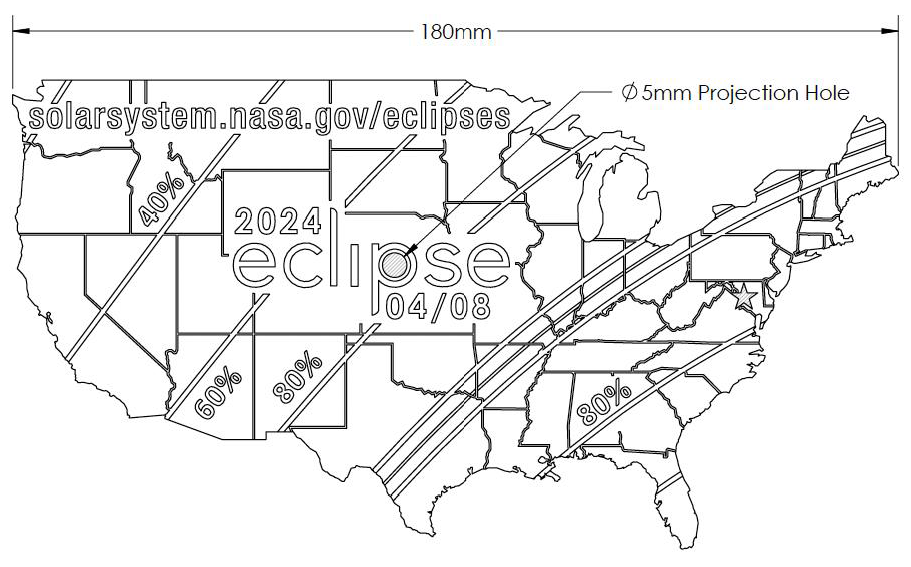
A 2D cutout of a USA eclipse map for Monday, April 8, 2024. Credit: NASA/J. Patrick Haas, https://mynasadata.larc.nasa.gov/sites/default/files/inline-images/Pinhole%20viewer%20total%20eclipse.png
- Make a prediction: What will you see using a pinhole projector during totality?
- Optional:
- See the extensions section of this lesson for a prediction activity
- If you don't want to use the template provided, you can make a pinhole projector from a box as shown in the How to Make a Pinhole Projector to View the Solar Eclipse video.
-
2024 Plan B: Direct Viewing: Use solar eclipse glasses to directly view the solar eclipse. Examine the following graphic about how to properly use solar eclipse glasses during a total solar eclipse.

Progression of a total solar eclipse from partial to total and pack to partial. https://mynasadata.larc.nasa.gov/sites/default/files/inline-images/Total%20Eclipse%20Images%20to%20crop.png, Credit: American Astronomical Society
- Have students answer the questions.
- For observers experiencing a total solar eclipse, when do you need to use solar eclipse glasses?
- For observers on the 100% line (path of totality)?
- For observers experiencing a partial solar eclipse, near the 100% line, but only at 95%?
- For observers experiencing a partial solar eclipse, on the 80% lines?
- For observers experiencing a partial solar eclipse, on the 60% line?
- For observers experiencing a partial solar eclipse, on the 40% line?
- Have students answer the questions.
-
- Have students take quiz to determine if they are ready to safely observe any type of eclipse. Use the Eclipse Safety Quiz Google Form by making a copy and assigning to your students.
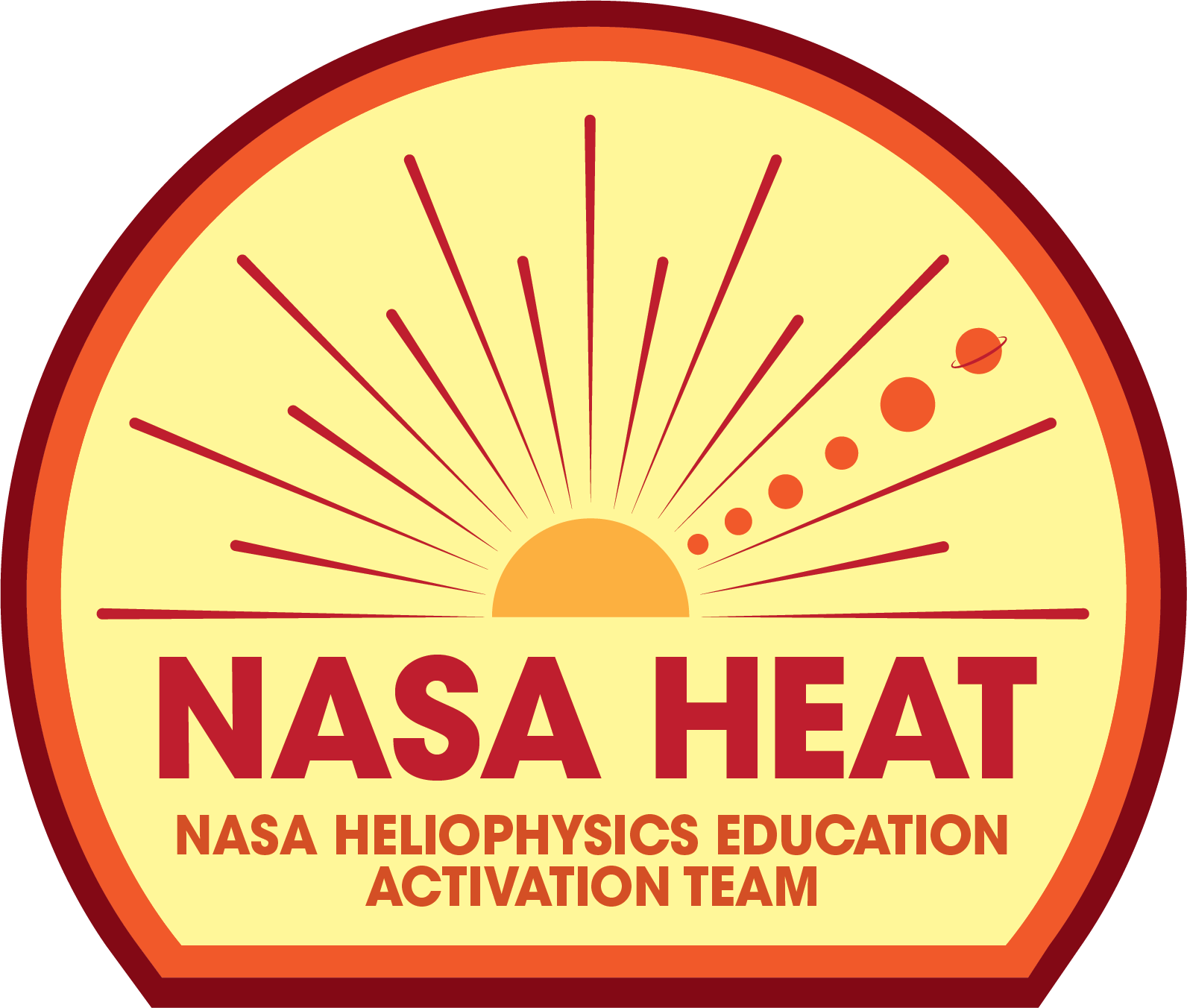
Sources:
- How to View a Solar Eclipse Safely. (n.d.). Solar Eclipse. Retrieved March 7, 2023, from https://eclipse.aas.org/eye-safety
- NASA Research | Science. (n.d.). NASA Solar System Exploration. Retrieved February 26, 2023, from https://solarsystem.nasa.gov/eclipses/science/nasa-research/
- Solar Viewing Projector | Total Solar Eclipse 2017. (n.d.). Solar Eclipse. Retrieved February 26, 2023, from https://eclipse2017.nasa.gov/solar-viewing-projector
- US eclipse map for Saturday, October 14, 2023. Credit: NASA/J. Patrick Haas
- A 2D cutout of a USA eclipse map for Monday, April 8, 2024. Credit: NASA/J. Patrick Haas
- What you need to Know about Monday’s Eclipse. (2017). Union Times. Retrieved March 10,2023 from https://www.timesunion.com/7dayarchive/article/Everything-you-need-to-know-about-the-eclipse-11945609.php#photo-13806972
- Types | About – NASA Solar System Exploration. (n.d.). NASA Solar System Exploration. Retrieved April 2, 2023, from https://solarsystem.nasa.gov/eclipses/about-eclipses/types/
- Garrison, M. (2023, March 8). SVS - The 2023 and 2024 Solar Eclipses: Map and Data. NASA Scientific Visualization Studio. Retrieved April 11, 2023, from https://svs.gsfc.nasa.gov/5073
- 2023 Annular Solar Eclipse - USA Map - NASA Pinhole Projector. (2023, February 13). NASA 3D Resources. Retrieved August 16, 2023, from https://nasa3d.arc.nasa.gov/detail/usa-eclipse-2023
- 2024 Total Solar Eclipse - USA Map - NASA Pinhole Projector. (2023, February 13). NASA 3D Resources. Retrieved August 16, 2023, from https://nasa3d.arc.nasa.gov/detail/usa-eclipse-2024
Disciplinary Core Ideas:
- ESS1B: Earth and the Solar System
Crosscutting Concepts:
- Scale, Proportion, and Quantity
Science and Engineering Practices:
- Planning and Carrying out Investigations
- Identify and practice safe methods for viewing the Sun
- Identify the different types of solar eclipses
- Examine eclipse data to determine what they will experience during the 2023 and 2024 solar eclipses
- Make a plan for safely viewing the upcoming 2023 and 2024 solar eclipses
- Calculate the diameter of the Sun using data collected from a pinhole projector
How do we safely observe a solar eclipse?
"Studying the innermost part of the corona – visible only during total solar eclipses – is key to answering fundamental questions about how heat and energy are transferred from the Sun out into the solar wind, the constant stream of particles that the Sun spews into the solar system. The solar wind can impact humans and technology at Earth, so understanding how it becomes accelerated at the Sun can help predict its impacts at home."
Learn more at NASA Eclipse Science.
Source:
NASA Research | Science. (n.d.). NASA Solar System Exploration. Retrieved February 26, 2023, from https://solarsystem.nasa.gov/eclipses/science/nasa-research/
- Pinhole projection predictions.
- Print the Pinhole Projector Prediction sheets and cut them for the students.
- Distribute the prediction slips to students to make their predictions.
- Distribute the result sheets to the students to show what they observe.
- Calculating the Diameter of the Sun with a Pinhole Projector
- Print the Calculating the Diameter of the Sun with a Pinhole Projector student sheets. Lead students through the calculation of the Sun's diameter and test if possible.

